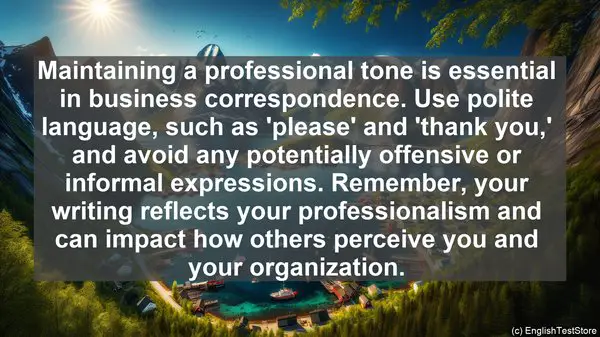Introduction: The Importance of Simple English in Business Correspondence
Welcome to today’s lesson. In the business world, clear and concise communication is crucial. And when it comes to writing business correspondence, using simple English is often the best approach. It ensures that your message is easily understood, regardless of the recipient’s language proficiency. Today, I’ll be sharing 10 tips that will help you master the art of writing simple English business correspondence at the B1 level. Let’s get started!
1. Start with a Clear Purpose Statement
When writing any business correspondence, it’s important to state your purpose right at the beginning. This helps the reader understand the context and prioritize their response. For example, if you’re writing an email to request a meeting, start with a concise statement like, ‘I would like to schedule a meeting to discuss XYZ.’ This sets the tone for the rest of your message.
2. Use Short Sentences and Paragraphs
Long, complex sentences can be confusing, especially for non-native English speakers. Instead, aim for shorter sentences that convey one idea at a time. Similarly, break your content into paragraphs, each focusing on a specific point. This not only makes your message easier to read but also helps the reader grasp the information more effectively.
3. Avoid Jargon and Technical Terms
While industry-specific jargon and technical terms have their place, they can often hinder understanding, especially for those outside your field. When writing in simple English, it’s best to use plain language that anyone can understand. If you must include technical terms, provide a brief explanation or use them sparingly, ensuring the context is clear.

4. Be Polite and Professional
Maintaining a professional tone is essential in business correspondence. Use polite language, such as ‘please’ and ‘thank you,’ and avoid any potentially offensive or informal expressions. Remember, your writing reflects your professionalism and can impact how others perceive you and your organization.
5. Proofread and Edit Carefully
Simple English doesn’t mean sloppy English. Always take the time to proofread your message for any grammatical or spelling errors. Read it aloud to ensure it flows smoothly and makes sense. If possible, have someone else review it as well. A well-edited message shows your attention to detail and enhances your credibility.
6. Use Bullet Points and Headings for Clarity
In longer emails or reports, it’s helpful to use bullet points or headings to organize your content. This not only makes it visually appealing but also allows the reader to quickly scan and locate the information they need. It’s a simple yet effective way to enhance readability.

7. Provide Context and Background Information
When writing to someone who may not be familiar with the topic, it’s important to provide sufficient context. Briefly explain any relevant background information, ensuring the reader can fully understand the message without needing to ask for additional details. This saves time for both parties and avoids any potential misunderstandings.
8. Use Templates and Examples
If you’re unsure how to structure a particular type of business correspondence, don’t hesitate to use templates or look for examples online. These resources can provide valuable guidance on the format, content, and language to use. Just ensure that any template or example you use is appropriate for your specific situation.
9. Be Mindful of Cultural Differences
In today’s global business environment, it’s crucial to be aware of cultural differences. Certain expressions or gestures that may be acceptable in one culture can be seen as offensive in another. When writing in simple English, it’s always a good idea to avoid any language or references that could be misinterpreted or deemed inappropriate.
10. Conclude with a Clear Call to Action
Finally, always end your business correspondence with a clear call to action. State what you expect the recipient to do or respond with, and provide any necessary deadlines or instructions. This ensures that your message doesn’t end up in a ‘to-do later’ pile and prompts a timely response.
